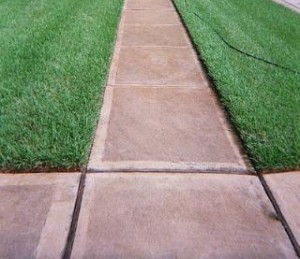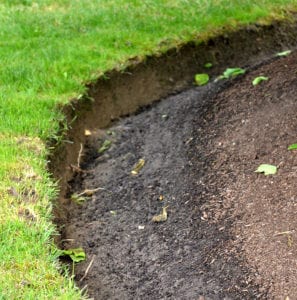
While some people my find yard work enjoyable, most folks, without a doubt don't like the thought of edging. Edging is the process of cleaning the "edges" of the lawn along sidewalks, driveways and flower beds. There are three basic ways to clean up the edges. You can use a weed trimmer, a motorized edger or a manual edging tool or garden spade.
Many newer weed trimmers will provide edging capabilities making it easy to trim around the house in the normal setting and then flip it over for edging walks and drives. This provides a nice neat edge that is relative quick and easy.
Dedicated edging tools are fast, powerful and cut a nice edge, but they are an extra piece of equipment and can be costly. The edge they leave is deeper than a weed trimmer and tends to last longer, though not necessarily all season. It may require a few passes a summer to keep your walks nice and tidy.
Manual tools are cheap and can be effective, but very time consuming. These are best for small spaces or those who truly need to fill a weekend with edging.
No troughs. 
One thing to avoid is creating large troughs along walks and drives. These are generally created with manual edging tools, such as a garden spade. Homeowners tend to think the more they cut back, the longer it will take to creep back over the sidewalk, driveway or flower bed. And that is true. But it also creates opportunities for weeds. Weeds thrive in exposed soil, so when you cut away the soil at a sharp angle, you invite weeds. To avoid the rush of weeds, cut a vertical edge with the spade or edging tool. Don't cut at an angle.
The image to the right shows a large area of exposed soil caused by aggressive edging. And while it provides a nice deep line, it provides prime conditions for weeds to emerge.
 While some people my find yard work enjoyable, most folks, without a doubt don't like the thought of edging. Edging is the process of cleaning the "edges" of the lawn along sidewalks, driveways and flower beds. There are three basic ways to clean up the edges. You can use a weed trimmer, a motorized edger or a manual edging tool or garden spade.
Many newer weed trimmers will provide edging capabilities making it easy to trim around the house in the normal setting and then flip it over for edging walks and drives. This provides a nice neat edge that is relative quick and easy.
Dedicated edging tools are fast, powerful and cut a nice edge, but they are an extra piece of equipment and can be costly. The edge they leave is deeper than a weed trimmer and tends to last longer, though not necessarily all season. It may require a few passes a summer to keep your walks nice and tidy.
Manual tools are cheap and can be effective, but very time consuming. These are best for small spaces or those who truly need to fill a weekend with edging.
No troughs.
While some people my find yard work enjoyable, most folks, without a doubt don't like the thought of edging. Edging is the process of cleaning the "edges" of the lawn along sidewalks, driveways and flower beds. There are three basic ways to clean up the edges. You can use a weed trimmer, a motorized edger or a manual edging tool or garden spade.
Many newer weed trimmers will provide edging capabilities making it easy to trim around the house in the normal setting and then flip it over for edging walks and drives. This provides a nice neat edge that is relative quick and easy.
Dedicated edging tools are fast, powerful and cut a nice edge, but they are an extra piece of equipment and can be costly. The edge they leave is deeper than a weed trimmer and tends to last longer, though not necessarily all season. It may require a few passes a summer to keep your walks nice and tidy.
Manual tools are cheap and can be effective, but very time consuming. These are best for small spaces or those who truly need to fill a weekend with edging.
No troughs.  One thing to avoid is creating large troughs along walks and drives. These are generally created with manual edging tools, such as a garden spade. Homeowners tend to think the more they cut back, the longer it will take to creep back over the sidewalk, driveway or flower bed. And that is true. But it also creates opportunities for weeds. Weeds thrive in exposed soil, so when you cut away the soil at a sharp angle, you invite weeds. To avoid the rush of weeds, cut a vertical edge with the spade or edging tool. Don't cut at an angle.
The image to the right shows a large area of exposed soil caused by aggressive edging. And while it provides a nice deep line, it provides prime conditions for weeds to emerge.
One thing to avoid is creating large troughs along walks and drives. These are generally created with manual edging tools, such as a garden spade. Homeowners tend to think the more they cut back, the longer it will take to creep back over the sidewalk, driveway or flower bed. And that is true. But it also creates opportunities for weeds. Weeds thrive in exposed soil, so when you cut away the soil at a sharp angle, you invite weeds. To avoid the rush of weeds, cut a vertical edge with the spade or edging tool. Don't cut at an angle.
The image to the right shows a large area of exposed soil caused by aggressive edging. And while it provides a nice deep line, it provides prime conditions for weeds to emerge.